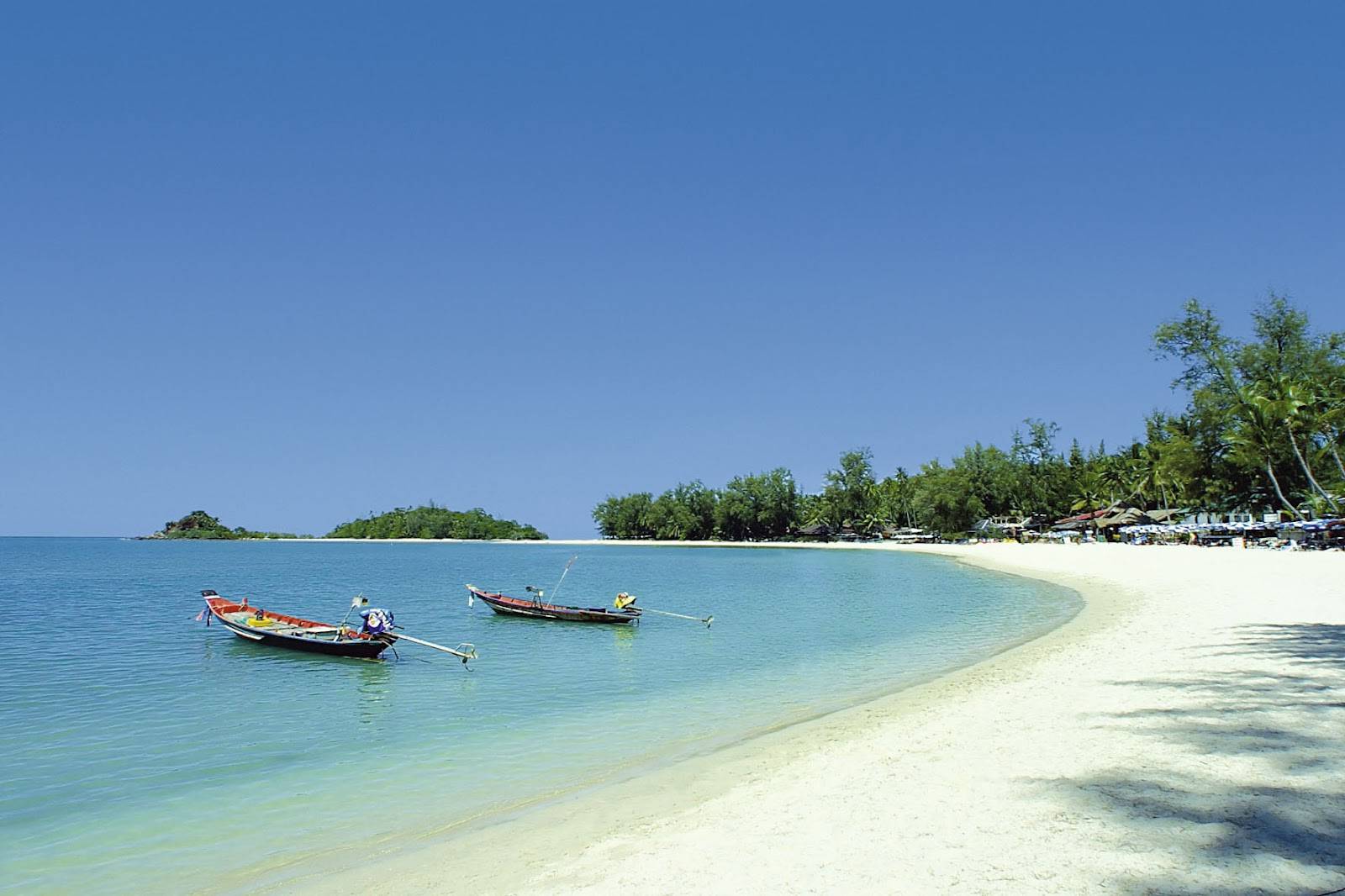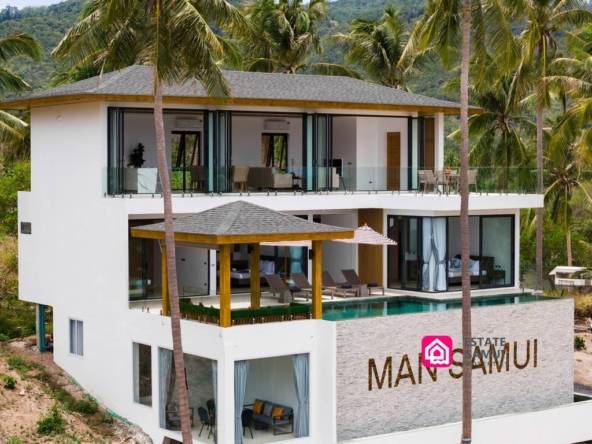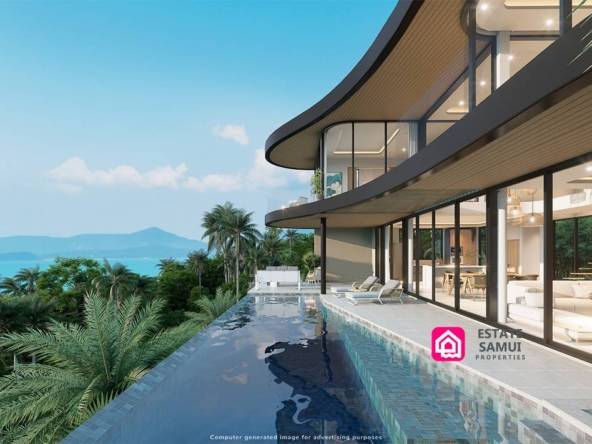Now renowned worldwide as the most beautiful of Thailand’s many tropical islands, Koh Samui was, for much of its own history, barely visited even by Thai people. The island is Thailand’s third largest although it is just 21 kilometers wide and 25 kilometers long.
Covered in lush vegetation and fringed by stunning beaches, Koh Samui has seen an explosion of visitors since its airport opened in 1989. Although the beach is undoubtedly the island’s primary draw, tourists are also attracted by a cosmopolitan range of dining options and world-class hotels and resorts. However, even before the first tourist stepped ashore in the early 1950’s, Koh Samui had held an allure for international travelers.
Like most of Thailand, Koh Samui is predominately Buddhist and the island boasts many stunning examples of Theravada Buddhist temples, such as its famous landmark Wat Phra Yai, which houses the Big Buddha. Samui is a cultural melting pot though, and significant Chinese and Islamic influences have helped shape the identity of its people.
THE REGION
Koh Samui is now the most important economic part of Surat Thani province, an area which was once part of the Srivijaya Kingdom, a Vedic empire founded by Indian Mahayana Buddhist migrants, which lasted from the 7th – 14th century AD. Surat Thani town was the northernmost outpost of the empire, which stretched all the way down the Malay Peninsula as far as Java and Sumatra.
As the empire grew, the towns Chaiya and Ban Don, also now in Surat Thani province, became the busiest commercial centres on the Malay Peninsula, flush with trade from rich Chinese merchants. They also became important ports for international trade when British, Dutch, Portuguese and other colonial powers opened sea routes through the Straits of Malacca, the Gulf of Siam and the South China Sea.
Throughout its final century, the Srivijaya Kingdom passed between the control of the Khmer and Sukhothai Kingdoms, before finally disintegrating when Java and Malaya broke away and declared their independence. The Buddhist and Brahim culture of the Srivijaya gave way to the beliefs of Islam that still predominate in the area, and in southern Thailand to this day.
After the fall of the Srivijaya, the area was divided into the three cities: Chaiya, Thatong and Kirirat, all under Siamese rule. In 1915, King Rama VI gathered the three cities into one administrative province, now named Surat Thani.
Throughout these centuries of historical power shifts, Samui remained a relatively unknown place, familiar only to fishermen sheltering from storms blowing in from the South China Sea, and to Malay and Viet pirates hiding out after raids on loot-laden ships blown off course by bad weather. These pirates also prompted the few Thai people living on Samui some 150 years ago to move up into the mountainous highlands of the island. The Thais reasoned that living near the sea was too hot, too dangerous, and not particularly good for raising crops.
THE NAME
Maps dated 1687 show Koh Samui identified as ‘Pulo Cornam’ taken from the Malay language. No recorded history of the island exists prior to the nineteenth century, and most of what historical knowledge there is has been passed down through generations of local residents.
Commonly held ideas about how the island came to be called Samui suggest that the name of a common local tree called ‘mui’ was lengthened over time. A more likely explanation is that a Chinese word for safe haven, ‘saboey’, was adopted and gradually mispronounced. In 1837, a then sophisticated map of Hindoostan and Farther India shows the Siamese capital as Bangkok, and Koh Samui as ‘Larchim Island’. Neighbouring Koh Phangan is recorded as ‘Carnon Island’, and both islands are located in ‘The Isthmus of Kraw’, the name still given to the giant bay stretching from Chumpon to Samui.
The British naturalist H.N. Ridley – certainly one of the first westerners to record a visit to the island (during his botanical excursions in peninsular Thailand) – published An Account of a Botanical Expedition to Lower Siam in 1912, and The Plants of Koh Samui and Koh Pennan in 1915 obviously referring to the modern name.
MUSLIM FISHERMAN
Samui’s small Muslim community is located in Hua Thanon on the island’s southeast coast. The men make a living by fishing in Samui’s waters and it is likely that many of them are directly descended from the Orang Laut, or Southern Sea Gypsies.
Five hundred years ago, the Orang Laut were the pirates of South East Asia, roaming the Straits of Malacca in bands, raiding, burning and pillaging. Whoever controlled the Orang Laut controlled the trade routes and the sea gypsies deeply influenced the political history of Malaysia, Thailand, Indonesia and the Philippines
In 1511 the Portuguese gained control of the ‘Land of Abundance’ as Malacca in Malaysia was then known. The Sultan of Malacca fled with his family to Johor, and the Malaccan Empire lay in ruins, to be rebuilt and fortified by the European conquerors.
The Orang Laut took it upon themselves to protect the Sultan and the Malacca royal family. The Sultan’s Orang Laut retainers took him to the east coast of Sumatra where he eventually died. The powerful magic and prestige of the Malaya line passed from the Sultanate of Malacca to the kingdom of Johor when his son Sultan Alauddin Riayat Syah married into the royal family of Pahang and built his palace at Pekan Tua on the Johor River in the early 1530’s.
The Orang Laut were so important and highly regarded by the Malays that gradually the two communities fused into one, with Malay men marrying Orang Laut women. Eventually the Orang Laut converted to Islam and adopted the Malay language and customs.
Those who chose to retain their old way of nomadic life moved on to Southern Thailand and many mixed with the mainland Thais from around Pattani before heading to Koh Samui.
Hua Thanon’s Islamic community lives a fully integrated existence within Samui’s traditional Buddhist culture, with both Muslims and Buddhists identifying more as a united ‘Chao Samui’ (original Samui) community than as a people separated by fundamentalist faith or by historical or ethnic difference.
THE ARRIVAL OF THE CHINESE
In the 1850’s the first seafaring Chinese traders came ashore at Lipa Yai beach on Koh Samui’s west coast and erected a shrine to the sea goddess, asking for protection on their return to Hainan Island. But they returned to the bloodshed and political upheavals of the Opium Wars, which were completely disrupting the old way of life and the economy of all of Southern China, Hainan included. A number of peasant revolts started in the late 1840’s, culminating in the Taiping Rebellion, the biggest uprising in Chinese history, in which more than 20 million people died. This was the most serious of several internal disturbances that rocked China between 1850 and 1873, the exact period Chinese traders found and eventually settled on Koh Samui.
As a result of this turmoil at home, the people of the Kongjeaw and Bon Cheu districts of Hainan organized a plan to set up a small settlement on Koh Samui, which would facilitate access to the southern trading posts. They set up on the shore and brought extra supplies in case of pirate attack. Eventually the river at Nathon was chosen as the principal location of the first settlement. Samui’s rivers ran with the same traces of red soil as those on Hainan Island – a good omen in Chinese eyes. Twenty people were in the first group that stayed on. Every year from then on, more Chinese settlers came to Samui. They eventually erected their classic Chinese-style shop houses in what is now known as the ‘Middle Road’, and the small community not only survived, but thrived, becoming the foundation of Nathon, the first and current capital of Samui.
Nathon’s Hainan Temple was erected as a combination social club and schoolhouse, and was officially consecrated in 1862, the same year American President Abraham Lincoln was fighting a bloody civil war to abolish slavery, and when the British Empire still possessed a large portion of the known world, including India, Burma, Malaysia and Singapore.
The temple is a tiny, simple structure. The interior beams supporting the roof were constructed with dovetail joints by craftsmen on Hainan, imported by ship and assembled in Nathon. Today’s Samui-Chinese visit the temple to make good luck offerings at the small shrines dedicated to Chinese deities such as Huang Kun, the God of Incense; Yu-Qiang, the Sea God; and the omnipresent personification of compassion, the Kwan Yin, or as the Thais pronounce it, Guan Im. A large, white stone statue of the Guan Im – the most widely accepted Chinese deity in Thai culture – can be seen in the small garden between the domestic arrival lounge and the international terminal at Samui airport.
COCONUT ISLAND
Whilst it was the abundant fishing that lured and sustained the early Hainan Chinese settlers, it was in fact coconuts that were the economic foundation of the island’s community for the majority of Koh Samui’s known history. Although coconuts never generated the excessive wealth once created by the rubber and sugar crops of the tropical plantations of the 18th and 19th century world, there was a time when the coconuts in Koh Samui made a very good living for local planters.
Coconuts are seedpods that are perfectly designed for water-borne dispersal. There are two major classes of coconuts, which are distinguished by their stature: the tall and the dwarf palms. The palms seen on Koh Samui are the tall variety, which are slow to mature and first flower six to ten years after planting. They produce medium to large size nuts and have a nut-producing span of sixty to seventy years. The trees themselves can live to be well over a hundred years old, and can grow to thirty-five meters high. Coconuts have been an important food source in most tropical countries for centuries and are an essential ingredient in Thai cooking.
Initially, the coconuts were piled onto wooden carts and hauled by water buffalo down to a make-shift wharf at Nathon. From there, they were sold to traders who would load them onto ships and resale in Bangkok. However, immediately after World War II – twenty years before Koh Samui had anything even resembling roads – a motley collection of heavy duty US military trucks was transported to the island from the nearby mainland to service the plantations. Many of these military trucks are still operating today and are a source of great local pride.
One of the most remarkable aspects of Koh Samui’s coconut industry was the training of pet monkeys to climb the coconut trees and retrieve the nuts from the top. Harvesting the coconuts with long bamboo poles is considered a safer and more efficient method than climbing the trees, but there comes a point when the trees are too tall to reach the coconuts in this way. Very tall trees catch the wind though and can be dangerous for people to climb, so monkeys were trained to do the job instead.
The practice has declined though, and now many of Koh Samui’s monkeys are treated as little more than circus clowns, performing ‘Monkey Shows’ for tourists. It is a shame that they are no longer the valuable and highly trained partners of the old-school coconut farmers.
The worldwide oversupply of coconuts has lowered their value and, although plantations still dominate much of Koh Samui today, tourism and property development have replaced the coconut industry as the mainstay of Koh Samui’s economy. The majority of coconuts still grown on Koh Samui are shipped to Bangkok, where modern facilities process them into dozens of different products.
THE FIRST TOURIST
Darrell G Berrigan was based in Thailand with the OSS, the precursor to the CIA, during World War II and, like his fellow intelligence officer, silk trade pioneer, Jim Thompson, he settled in Thailand after the end of the war. An ebullient, gay American, Berrigan began a new career as a journalist in Bangkok and was for many years The New York Times’ Thailand correspondent. He was also the founding editor of The Bangkok World, a newspaper launched in 1957 by alleged drug kingpin, Police General Phao Sriyanond. The turbulent political atmosphere in the country at that time forced Phao into exile in Switzerland shortly before Field Marshall Sarit Thanarat seized power in a coup in October 1958. Under Berrigan’s direction, The Bangkok World became Thailand’s pre-eminent English language daily newspaper and was constantly engaged in a fierce circulation battle with The Bangkok Post, its main competitor, which was established in 1947.
During his early years in Bangkok, Berrigan became acquainted with Khun Seethawit, a businessman from Samui who was living in the city. Berrigan was intrigued by Seethawit’s stories of the island and decided to visit it with his friend in 1952, when he was 38 years old. The voyage, by coconut boat, took over a week. Arriving in Nathon, the island’s commercial centre, the two men were mobbed by a crowd of curious locals, many of whom had never before seen a farang.
Travelling by coconut truck over the mountanour interior to Hua Thanon, they worked their way up the coast to Wat Ratamaran, near Hin Hin and Hin Yai, where they stayed. At the time, there was very little infrastructure on the island: roads were little more than dirt tracks, there was no electricity outside of Nathon and Maenam, and water came straight from wells. Samui had been part of Surat Thani Province for over 30 years and was under its legal jurisdiction and administrative control. There was a small police station in Nathon, with five officers, but most decisions were still made by poo yai ban (village headmen).
On his return to Bangkok, Berrigan wrote several stories about Samui in the local press and later in The Bangkok World, which helped lay the foundations for the island’s tourism industry. He was so enraptured by the island’s tranquility that he told friends in Bangkok that he wished to be laid to rest on Samui after his death. Unfortunately, this came much sooner than expected: Berrigan was murdered in Bangkok in 1965. He did get his wish though, as his bones were returned to Wat Ratamaran to be interred, where they remain to this day.
THE ROAD
Shortly after Berrigan’s untimely death, work began on a project that would revolutionise life on Koh Samui: the construction of Route 4169, the island’s ring road. The idea of a ring road had been discussed for many years, but the island’s mountainous terrain had made the project impossible until 1967 when Nathon’s poo yai ban Khun Dilok Suthiklom, took action and asked the Government to supply the necessary construction equipment. Before it arrived, hundreds of people set to work cutting trees and clearing a path around the island.
The most challenging stretches were between Nathon and Maenam, and Lamai and Chaweng, where it was necessary to dynamite the mountains in order to lay the road. The monsoon caused frequent construction delays over the following years until finally, in 1972, concrete arrived from Bangkok and the 52km road was completed.
As the road neared completion, the first foreign visitors began to arrive on a regular basis to the island. Coming by night boat from Surat Thani, they would stay in the island’s only hotel in Nathon. Day trips, which cost 50 Baht, were organised by Khun Prawit Chaiyen, Samui’s only English speaker at the time.
Eventually, as visitors began to arrive in greater numbers, more accommodation options became available. A private house in Chaweng (today’s First Bungalow) started to take visitors in 1974, and the following year the island’s first true resort, the 40 room Palm Bungalow, opened in Lamai. Rooms cost just 20 Baht per night and if all of them were taken, visitors could sleep on the beach – within the range of the Palm’s restaurant light – for just 5 Baht.
By now, the island was firmly on the Goa-Bali backpacker trail and European hippies began to arrive alongside Australians who were on their way home from working in the UK. The transformation of the island’s economy continued rapidly throughout the 1980’s and 90’s as the price of coconuts continued to drop and the value of tourism continued to rise. The opening of Samui Airport put the island firmly on the map for tourists in search of a two-week holiday, rather than months of adventure.
Throughout its development though, the character of Samui has remained essentially unchanged. The relaxed, friendly atmosphere and stunning natural beauty that beguiled the Chinese sailors of the 1850’s and Darrell Berrigan a century later, now attract visitors from all corners of the globe, and will no doubt continue to do so for many years to come.




